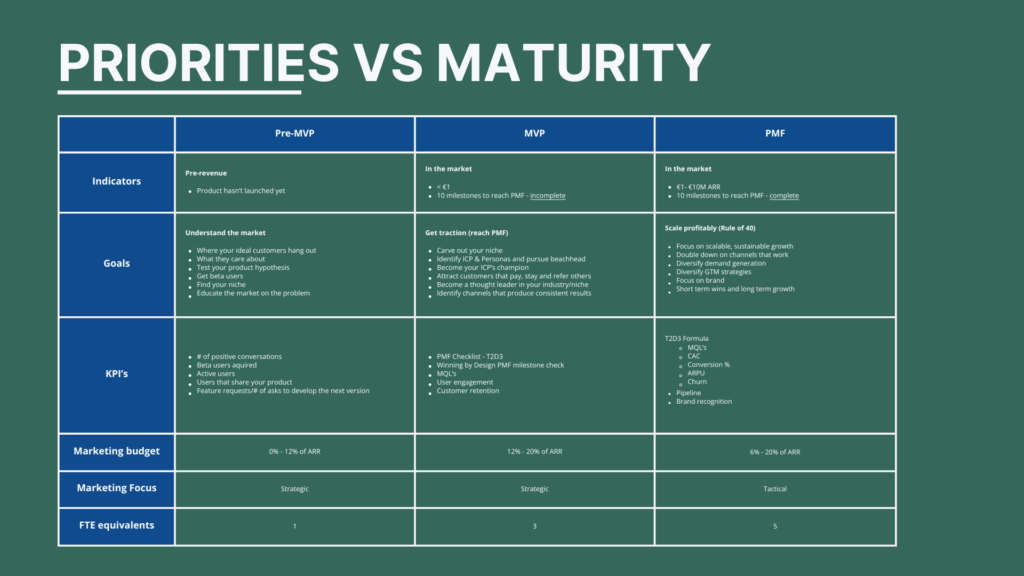The question plagues every B2B SaaS Founder at some point: “When is the right time to seriously invest in marketing?” Many companies grapple with the timing of their marketing investments, often unsure whether to ramp up efforts too early or risk falling behind by waiting too long. Making this decision correctly is crucial, as it directly impacts company growth, resource allocation, and overall market competitiveness. This article serves as a definitive guide, revealing how product-market fit (PMF) acts as the pivotal indicator for making informed marketing investment decisions.
This guide is tailored for B2B SaaS founders, leaders, and investors who need clarity on when and how to scale their marketing efforts effectively. We’ll explore what constitutes a marketing investment, how to measure product-market fit, and provide a framework for timing your investments to maximize ROI.
Understanding Marketing Investment in the SaaS Context
It’s easy to think of marketing as simply running ads or sending emails. But in reality, marketing encompasses much more than basic communication.
What Constitutes “Marketing Investment”?
Marketing investment extends beyond surface-level activities. It includes:
- Strategic planning: Defining your target audience, understanding their pain points, and crafting a compelling value proposition.
- Content creation: Developing valuable content that educates prospects and positions your company as an industry expert.
- Campaign execution: Running targeted campaigns across various channels to attract and convert leads.
- Analytics and optimization: Tracking key metrics, analyzing performance, and continuously improving your marketing efforts.
- Hiring a team: Recruiting marketing team members with specific set of skills such as product marketing, content marketing, performance marketing etc.
- MarTech Stack implementation: No marketing team can function without the proper tooling, think of tools such as CRM + Marketing Automation, Email Marketing, Data Analytics + reporting tools, project management tools such as ClickUp or Notion, etc,
- Training of the team: Investing in the skillset of your team is crucial to not only be more effective and efficient in the execution of the marketing strategy, but also retaining your best people. With the rise of AI agents and LLM’s, this becomes more crucial.
You’re always doing marketing to some extent. Whether it’s onboarding a new customer or sending a simple email, these actions contribute to the overall customer journey. However, truly investing in marketing means dedicating specific resources to build a scalable and sustainable marketing function.
The Evolution of Marketing Needs
In the early stages of a SaaS company, marketing is often handled by one of the co-founders or the head of product, typically “on the side of their desk”. This approach works initially, but as the company grows, these leaders need to focus full-time on their core responsibilities.
Here are some signs that indicate the need for dedicated marketing resources:
- Inconsistent lead generation: Relying solely on word-of-mouth or founder-led sales efforts becomes unsustainable.
- Lack of brand awareness: Difficulty in differentiating your product from competitors.
- Missed opportunities: Inability to capitalize on emerging market trends or customer needs.
- Data-driven decision-making: Absence of a structured approach to tracking and optimizing marketing performance.

The chart above highlights how marketing needs change as a startup goes through the stages of growth and it also provides an estimate of the marketing budget and FTE’s to hire.
Product-Market Fit: The Critical Milestone
Before pouring significant resources into marketing, it’s crucial to ensure you’ve achieved product-market fit. But what is product-market fit, and how do you know when you have it?
Defining Product-Market Fit
Product-market fit is the degree to which a product satisfies a strong market demand. It’s about more than just having a good product; it’s about having a product that resonates with your target audience and solves a real problem for them.
Key indicators of PMF include:
- High customer retention: A significant percentage of users continue using your product over time, indicating they derive ongoing value.
- Low churn rate: Customers are not leaving your product, suggesting they are satisfied with the solution it provides.
- Strong Net Promoter Score (NPS): Customers are highly likely to recommend your product to others, demonstrating loyalty and advocacy.
- Increasing usage rates: Customers are actively using your product and engaging with its features, indicating it’s becoming an integral part of their workflow.
- Decreasing Customer Acquisition Cost (CAC): Demand can be generated efficiently at scale, often due to word-of-mouth and organic growth.
The “pay and stay” principle, is a fundamental aspect of PMF. Customers not only buy your product but also stick around, demonstrating its long-term value.
The Engaged Advocates Framework
While quantitative metrics are important, qualitative feedback is equally crucial. The Engaged Advocates Framework offers a valuable perspective. An Engaged Advocate is someone who:
- Actively uses your product: They log in regularly and incorporate it into their daily routines.
- Provides positive feedback: They express satisfaction with the product experience, either through surveys, reviews, or direct communication.
- Shares the product with others: They actively refer new customers, recommend the product on social media, or participate in community discussions.
You don’t need a massive number of Engaged Advocates to achieve PMF. As few as 10 dedicated advocates can be enough to signal that you’re on the right track. Read the following article for a complete PMF checklist.
Measuring Product-Market Fit
Measuring product-market fit requires a combination of quantitative and qualitative assessments. Here’s a breakdown of key metrics and practical methods:
Key Metrics for Assessment
- Referral rates and patterns: A high percentage of customers coming from referrals indicates strong word-of-mouth and customer satisfaction.
- Customer satisfaction indicators: NPS scores, customer satisfaction (CSAT) scores, and customer reviews provide insights into how happy your customers are with your product.
- Usage patterns and engagement: Tracking daily/monthly active users (DAU/MAU), feature engagement, and session duration reveals how deeply customers are interacting with your product.
- Customer feedback quality: Analyzing the sentiment and content of customer feedback helps identify areas for improvement and understand what customers value most.
Practical Assessment Methods
- Customer interviews and surveys: Directly engaging with customers to gather feedback on their experience, pain points, and satisfaction levels.
- Product usage analytics: Using tools to track how customers are using your product, identifying popular features, and uncovering areas where they may be struggling.
- Referral tracking: Implementing a system to track the source of new customers, identifying those who came through referrals.
- Pattern recognition in customer base: Identifying common characteristics among your happiest customers, such as industry, company size, or technology stack.
Timing Your Marketing Investment
Once you’ve determined that you have product-market fit, the next step is to strategically time your marketing investment.
The Right Moment to Scale
As soon as you think you have product-market fit, it’s time to hire marketing talent to amplify your existing success. This doesn’t necessarily mean going “all in” immediately, but rather starting to build the necessary capabilities to scale your marketing efforts.
Consider these indicators of readiness:
- Consistent customer acquisition: You’re able to acquire new customers consistently and predictably.
- Positive customer feedback: Customers are consistently expressing satisfaction with your product and recommending it to others.
- Scalable product: Your product is stable and can handle increased usage without significant issues.
- Clear value proposition: You have a well-defined value proposition that resonates with your target audience.
Implementation Strategy
- Building internal capabilities: Hiring a dedicated marketing team to focus on building your brand, generating leads, and driving customer acquisition.
- Agency partnerships: Partnering with a marketing agency to provide specialized expertise and support your internal team.
- Resource allocation: Allocating sufficient budget and resources to support your marketing efforts.
- Marketing team structure: Defining clear roles and responsibilities within your marketing team to ensure effective execution.
Common Pitfalls to Avoid
- Premature investment: Investing heavily in marketing before achieving product-market fit can lead to wasted resources and poor ROI.
- Delayed investment: Waiting too long to invest in marketing can result in missed opportunities and slower growth.
- Resource misallocation: Allocating resources to the wrong marketing channels or activities can diminish the impact of your efforts.
- Strategy misalignment: Failing to align your marketing strategy with your overall business goals can lead to ineffective campaigns and poor results.
Future-Proofing Your Marketing Investment
The marketing landscape is constantly evolving, so it’s crucial to build a scalable and adaptable marketing foundation.
Scalable Marketing Foundations
- Building sustainable systems: Creating repeatable processes and workflows to ensure consistent marketing performance.
- Measuring ROI: Tracking key metrics and analyzing the return on your marketing investments to optimize performance.
- Adaptation strategies: Developing contingency plans to address market changes, technology disruptions, and evolving customer behavior.
- Growth frameworks: Implementing frameworks to guide your marketing efforts and ensure alignment with your overall business goals.
Long-term Considerations
- Market evolution: Staying abreast of changes in your target market and adapting your marketing strategy accordingly.
- Technology adoption: Embracing new technologies, such as AI Agents and platforms to enhance your marketing capabilities.
- Customer behavior changes: Understanding how customer preferences and behaviors are evolving and adjusting your approach to meet their needs.
- Industry trends: Monitoring industry trends and adapting your marketing strategy to capitalize on emerging opportunities.
In short
Timing your marketing investment is a critical decision for B2B SaaS companies. By focusing on achieving product-market fit and using the Engaged Advocates Framework, you can make informed decisions that maximize your ROI and drive sustainable growth.
Action Steps for Assessing Readiness
- Evaluate your product-market fit: Use the metrics and methods outlined in this article to assess your current level of PMF.
- Identify your Engaged Advocates: Determine how many customers meet the criteria of active usage, positive feedback, and referral behavior.
- Assess your marketing capabilities: Evaluate your current marketing team, resources, and strategy.
- Develop a phased investment plan: Create a plan to gradually increase your marketing investments as you achieve key milestones.
By taking these steps, you can confidently navigate the complex landscape of marketing investment and position your B2B SaaS company for long-term success.

